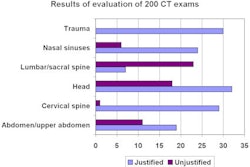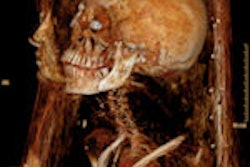Adding computer-aided detection (CAD) increases both the efficiency and cost-effectiveness of virtual colonoscopy (also known as CT colonography, or CTC) screening, according to a new model-based analysis.
Most of the gains resulted from the use of CAD with inexperienced readers. But even with experienced readers, CAD use substantially improved the cost-effectiveness of CTC, researchers wrote in the February 2009 issue of Radiology (Vol. 250:2, pp. 488-497). The model did not show optical colonoscopy to be a cost-effective alternative.
While the use of CAD is associated with a substantial increase in sensitivity for detecting polyps 6 mm or larger, the amount of the increase varies with the experience of the reader -- and comes at the cost of reduced specificity, wrote Dr. Daniele Regge and colleagues in the multicenter analysis.
In terms of cost-effectiveness, "expending excessive resources on the endoscopic follow-up of false-positive results should be weighed against the possible benefit of the detection of clinically relevant lesions," they added.
Regge is from the Institute for Cancer Research and Treatment in Candiolo, Italy, and his co-authors included Dr. Cesare Hassan from Nuovo Regina Margherita Hospital in Rome, Dr. Andrea Laghi and Dr. Franco Iafrate from the University of Rome "La Sapienza," and Dr. Perry Pickhardt from the University of Wisconsin in Madison. The study analyzed the cost-effectiveness of adding CAD to a VC screening program, comparing it to other colorectal cancer prevention strategies.
Using a Markov model, which models the transition of patients across a predefined set of health states (e.g., no colorectal lesions; diminutive [≤ 5 mm], medium [6-9 mm], or large [≥ 10 mm] adenomatous polyps; localized, regional, or distant colorectal cancer; and colorectal cancer-related death), the researchers evaluated screening strategies by comparing VC with and without the use of CAD to both flexible sigmoidoscopy (FS) and optical colonoscopy.
The study analyzed a hypothetical population of 100,000 50-year-olds who underwent colorectal cancer screening every 10 years until age 80. The model estimated sensitivities for both experienced and inexperienced VC readers using CAD based on a systematic review of the literature. The cost of adding a CAD review to a VC study was pegged at $50.
The detection of a lesion larger than 6 mm at CT colonography was followed up by using optical colonoscopy with polypectomy or biopsy, and the model also included the impact of complications from colonoscopy. The accuracy of experienced (> 75 CTC cases) readers was compared with that of inexperienced (< 20 CTC cases) readers based on the results of two large trials.
"It could be argued that the simulation of [colorectal cancer (CRC)] screening performed by inexperienced readers is of marginal importance, since it seems obvious that only highly qualified specialists should be involved in screening programs," Regge and colleagues wrote. "However, it has been consistently reported in previous experiences with endoscopic screening that there is a wide variability in accuracy among different operators, resulting in the risk of suboptimal efficacy in those subjects screened by specialists with an inadequate technique."
Estimates of the efficacy of CAD were derived from three recent series in which CAD was added to the reading process, the authors explained. With CAD, the mean sensitivity increased from 49.5% to 60.8% for 6- to 9-mm polyps and from 64.8% to 86.1% for polyps 10 mm or larger. The mean specificity decreased from 88.7% to 81.9%.
"Because it is unclear whether CAD may improve sensitivity for polyps 10 mm or larger for experienced readers, we conservatively decided not to assume that change in this analysis, which may penalize the cost-effectiveness of CT colonography with CAD by reducing its benefit on the life expectancy of the simulated population," the group wrote.
The results showed that all types of screening were cost-effective compared with no screening, with incremental cost-effectiveness ratios (ICER) ranging from $8,489 to $16,369 per life-year gained.
The limited costs of CAD were well compensated by gains in life expectancy. Adding CAD to VC at baseline yielded 9% and 2% increases in colorectal cancer prevention for inexperienced and experienced readers, respectively, compared to VC without CAD. The cost of screening rose by 3% to 5% when CAD was added at a cost of $50 per patient.
The incremental cost-effectiveness ratios of VC with CAD compared to VC without CAD were $8,661 and $61,354 per life-year gained for inexperienced and experienced readers, respectively. Conversely, optical colonoscopy was not a cost-effective alternative to VC with CAD performed by experienced readers, with an ICER of $498,668 per life-year gained.
Because of the higher sensitivity for colorectal cancer of virtual colonoscopy versus flexible sigmoidoscopy (95% versus 66%), the number of life-years saved with VC without CAD was slightly higher than that of FS. Virtual colonoscopy with the addition of CAD performed by inexperienced readers prevented 60% of colorectal cancers, corresponding to a 9% increase in colorectal cancer prevention compared to results without CAD.
"Our study shows that the addition of CAD to CT colonography screening is a clinically effective and cost-effective strategy for both experienced and inexperienced readers," the researchers wrote. "In particular, we estimated a substantial improvement in efficacy when CAD is added to examinations performed by inexperienced readers, increasing the CRC prevention rate from 51% to 60%."
The smaller increase in colorectal cancer prevention seen when experienced readers used CAD was mainly due to the assumption that CAD provides little additional sensitivity for the detection of polyps 10 mm and larger, the group noted.
"However, even with this assumption, the addition of CAD to an examination performed by an experienced reader substantially improved the cost-effectiveness profile of CT colonography, and the ICER of optical colonoscopy increased from less than $200,000 to more than $400,000," they wrote.
The authors noted a number of limitations, including uncertainties regarding the calculation of colorectal cancer-related costs and CAD-specific assumptions. For example, because there were no prospective studies on the efficacy of polypectomy in reducing colorectal cancer death, survival data from the Surveillance, Epidemiology, and End Results (SEER) database were compared to those of nonscreening cohorts, the authors explained. Also, there were few studies on the effectiveness of CAD, with much of the available data derived from higher-risk populations.
"In conclusion, our study shows that the CAD-related increase in sensitivity for lesions 6 mm or larger renders CT colonography screening both clinically effective and cost-effective for inexperienced and experienced readers, substantially raising the CRC prevention rate with only a modest increase in program costs," Regge and colleagues wrote.
By Eric Barnes
AuntMinnie.com staff writer
February 24, 2009
Related Reading
Virtual colonoscopy beginners do better with 3D data, February 5, 2009
Students ace VC reads after structured training, September 18, 2008
Radiographers perform VC with CAD -- and controversy, June 24, 2008
VC CAD helps junior readers catch up, May 4, 2006
VC CAD improves results for readers at all levels, April 7, 2006
Copyright © 2009 AuntMinnie.com




















